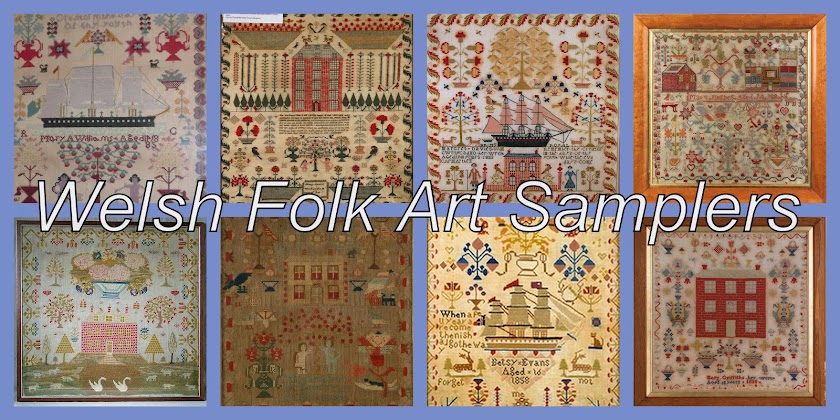I did say when I first started this blog that it would most probably be intermittent because I can only feature samplers when they appear! Well this morning this one turned up on an auction feed -
It is for sale in Pennsylvania! Had it been here in the UK I might well have been tempted to put a bid on it!
It is listed as a pictorial sampler as it has very little lettering, but the mixture of motifs alerted me as soon as I saw it! First of all I recognised the scene of the side elevation house with it field full of sheep, because I have a sampler with this very same scene which I know was worked in North Wales. I used this scene on a small reproduction sampler -
My original sampler has figures but I have also added a few little extras to this reproduction, the cat being one of them! I have also included the Welsh alphabet which is rarely if ever shown on Welsh samplers because the language was not encouraged at all at that time.
This auction sampler has so many things that drew it to my attention! Firstly, I recognised the house scene, but then it also had a church and a ship, both of which are a favourite motifs on Welsh samplers. Of course it also has the Tower of Babel which is common on all samplers and also some Berlin Woolwork patterns which were very often mixed in with traditional patterns on Welsh samplers in the latter half of the 19th century.
By far the most interesting motif is the so called "Hardgey Light" which I believe might be Bardsey Lighthouse which is situated off the coast of North Wales? I can't recall seeing a lighthouse on a Welsh sampler before, especially one that is named. Such a shame that it is so far from Welsh shores now? I would love it to return to its homeland!
It is for sale in Pennsylvania! Had it been here in the UK I might well have been tempted to put a bid on it!
It is listed as a pictorial sampler as it has very little lettering, but the mixture of motifs alerted me as soon as I saw it! First of all I recognised the scene of the side elevation house with it field full of sheep, because I have a sampler with this very same scene which I know was worked in North Wales. I used this scene on a small reproduction sampler -
My original sampler has figures but I have also added a few little extras to this reproduction, the cat being one of them! I have also included the Welsh alphabet which is rarely if ever shown on Welsh samplers because the language was not encouraged at all at that time.
This auction sampler has so many things that drew it to my attention! Firstly, I recognised the house scene, but then it also had a church and a ship, both of which are a favourite motifs on Welsh samplers. Of course it also has the Tower of Babel which is common on all samplers and also some Berlin Woolwork patterns which were very often mixed in with traditional patterns on Welsh samplers in the latter half of the 19th century.
By far the most interesting motif is the so called "Hardgey Light" which I believe might be Bardsey Lighthouse which is situated off the coast of North Wales? I can't recall seeing a lighthouse on a Welsh sampler before, especially one that is named. Such a shame that it is so far from Welsh shores now? I would love it to return to its homeland!
























